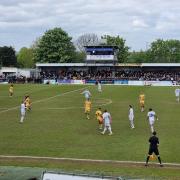
The importance of events in Hungary in 1956 in the future development of Cold War.
Following the death of Joseph Stalin on the 5th of March 1953, Nikita Khrushchev proceeded to take over as Soviet leader. He openly criticized Stalin’s policies and hinted in his ‘secret speech’ in 1956 that Soviet control would relax as he suggested that there should be peaceful co-existence with the West. He publicly established the idea of de-Stalinization which meant that USSR would no longer see itself as a dictatorship. Many Hungarians mistakenly believed that this would lead to the end of communism.
There was also a change in leadership in the West when Dwight Eisenhower was elected president of USA in 1952 and took office in 1953. As a result of this, people on both sides became hopeful of tensions being reduced and that a solution of the nuclear arms race would be found. Unfortunately, the hope for better relations was short-lived, both superpowers were spending large sums of money on their armed forces. In addition to that, in May 1955, West Germany joined NATO and the USSR responded with the formation of the Warsaw Pact.
In October 1956, the people of Hungary began to protest due to lack of political freedom, poor harvests, and food shortages. Khrushchev appointed a more liberal leader for Hungary, Imre Nagy, in hopes that the situation would calm down. Within days Nagy had established a democratic rule, reorganized the Hungarian government, and ended the one-party state in the country. Moreover, he authorised the immediate release of many political prisoners and persuaded Khrushchev to withdraw Soviet troops from Hungary which he reluctantly agreed to since he was desperate to end the social unrest in Hungary.
However, on the first of November, Nagy announced that Hungary would be leaving the Warsaw Pact. Khrushchev was appalled as he believed that if Hungary broke away, other Eastern European countries might follow. Nagy’s democratic rule began to damage the Soviet Unions reputation and he could not jeopardise USSR’s ideology of increasing its communist sphere of influence, placing the pro-communist government under huge threat. Which is why on the 4th of November, Khrushchev ordered the soviet invasion of Hungary. He sent 1,000 tanks to Budapest to stop the riots once and for all. It acted with great brutality and around 20,000 Hungarians were killed. This was done to re-establish USSR’s control and instil fear in the minds of the communist countries, securing Khrushchev’s position in the Soviet Union. Members of the Warsaw pact knew that they must do as they’re told. In 1958, the Hungarian government announced that Imre Nagy had been tried and executed. His death acted as a lesson to the leaders of the socialist countries and strengthened his sense of power and control.
The failure of the Hungarian uprising reflected poorly on the west since they couldn’t back up their promises of military support. Nevertheless, the USA still strongly opposed the Soviet invasion of Hungary. When Nagy had proposed of leaving, the Western countries supported the movement and even regularly broadcasted messages urging eastern Europeans to stand up against the communist regime. Some NATO nations even took in Hungarian refugees but offered no military support during the crisis. It showed the world that the US could not fully support Hungary in their time of need. This was because a military attack against the east could easily trigger a nuclear war, resulting in, mutually assured destruction. A risk the west was not willing to take. This gave an upper hand to Khrushchev as he became more confident in dealing with the US since he knew they were not likely to risk-taking military action.
This soured relations between the superpowers. This would lead to an increased level of tensions as neither side would trust each other and both countries were a push of a button away from the nuclear war which could impact the entire world.



























